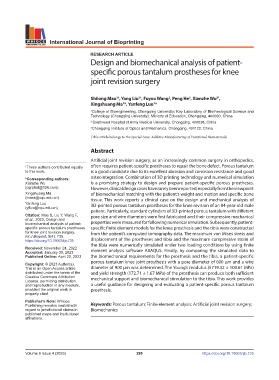Page 297 - IJB-9-4
P. 297
International Journal of Bioprinting
RESEARCH ARTICLE
Design and biomechanical analysis of patient-
specific porous tantalum prostheses for knee
joint revision surgery
Shilong Mao , Yang Liu , Fuyou Wang , Peng He , Xianzhe Wu ,
3
1†
2
3*
1†
Xingshuang Ma *, Yanfeng Luo *
1
1
1 College of Bioengineering, Chongqing University; Key Laboratory of Biorheological Science and
Technology (Chongqing University), Ministry of Education, Chongqing, 400030, China
2 Southwest Hospital of Army Medical University, Chongqing, 400038, China
3 Chongqing Institute of Optics and Mechanics, Chongqing, 401122, China
(This article belongs to the Special Issue: Additive Manufacturing of Functional Biomaterials)
Abstract
Artificial joint revision surgery, as an increasingly common surgery in orthopedics,
† These authors contributed equally often requires patient-specific prostheses to repair the bone defect. Porous tantalum
to this work. is a good candidate due to its excellent abrasion and corrosion resistance and good
*Corresponding authors: osteointegration. Combination of 3D printing technology and numerical simulation
Xianzhe Wu is a promising strategy to design and prepare patient-specific porous prostheses.
(cqrptad@126.com) However, clinical design cases have rarely been reported, especially from the viewpoint
Xingshuang Ma of biomechanical matching with the patient’s weight and motion and specific bone
(maxs@cqu.edu.cn) tissue. This work reports a clinical case on the design and mechanical analysis of
Yanfeng Luo 3D-printed porous tantalum prostheses for the knee revision of an 84-year-old male
(yfluo@cqu.edu.cn)
patient. Particularly, standard cylinders of 3D-printed porous tantalum with different
Citation: Mao S, Liu Y, Wang F, pore size and wire diameters were first fabricated and their compressive mechanical
et al., 2023, Design and
biomechanical analysis of patient- properties were measured for following numerical simulation. Subsequently, patient-
specific porous tantalum prostheses specific finite element models for the knee prosthesis and the tibia were constructed
for knee joint revision surgery. from the patient’s computed tomography data. The maximum von Mises stress and
Int J Bioprint, 9(4): 735.
https://doi.org/10.18063/ijb.735 displacement of the prostheses and tibia and the maximum compressive strain of
the tibia were numerically simulated under two loading conditions by using finite
Received: November 24, 2022
Accepted: January 30, 2023 element analysis software ABAQUS. Finally, by comparing the simulated data to
Published Online: April 20, 2023 the biomechanical requirements for the prosthesis and the tibia, a patient-specific
porous tantalum knee joint prosthesis with a pore diameter of 600 μm and a wire
Copyright: © 2023 Author(s).
This is an Open Access article diameter of 900 μm was determined. The Young’s modulus (5719.32 ± 100.61 MPa)
distributed under the terms of the and yield strength (172.71 ± 1.67 MPa) of the prosthesis can produce both sufficient
Creative Commons Attribution mechanical support and biomechanical stimulation to the tibia. This work provides
License, permitting distribution
and reproduction in any medium, a useful guidance for designing and evaluating a patient-specific porous tantalum
provided the original work is prosthesis.
properly cited.
Publisher’s Note: Whioce
Publishing remains neutral with Keywords: Porous tantalum; Finite element analysis; Artificial joint revision surgery;
regard to jurisdictional claims in Biomechanics
published maps and institutional
affiliations.
Volume 9 Issue 4 (2023) 289 https://doi.org/10.18063/ijb.735

